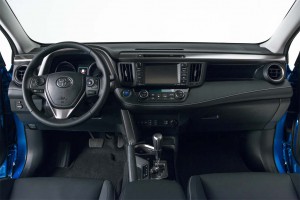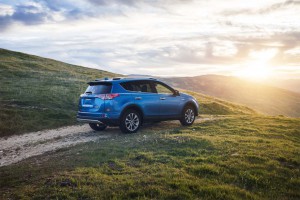Toyota has gone to extraordinary lengths over the years to build up its hybrid business and most of the effort has been centered on the Prius.
The Japanese auto giant also has moved to amortize its investment by using the hybrid technology in other vehicles with varying degrees of success. But one place where the idea of extending the hybrid technology to other vehicles clearly has worked is in Toyota’s compact sport utility, the popular RAV4.
The RAV4 is one of the most important vehicles sold by the company and it is critical to the continuing popularity of the Toyota brand. But adding the hybrid technology to the RAV4 hasn’t diminished its overall appeal vehicle one bit in my humble opinion.
Instead, Toyota’s continuing effort to improve the performance of its hybrid powertrain is evident in RAV4. Overall, the powertrain in the hybrid RAV4 is practically invisible to the driver out one road, which, I suspect, is pretty much way the owners of hybrids prefer it.
The RAV4 shifts smoothly and performs matches up well with any other compact sport utility vehicle on the road. In fact, it seemed to have a little more zip than the Chevrolet Equinox, which GM is beginning to replace with a new model, or the Ford escape.
(Toyota investing $1.33B in Kentucky plant. To find out more, Click Here.)
The 2017 RAV4 Hybrid combines the power from a 2.5-liter Atkinson-cycle four-cylinder engine and a small high-torque electric motor through its transaxle. The software does some essential work but the RAV4 Hybrid delivers combined 194 system horsepower and Toyota maintains the RAV4 Hybrid can jump from zero to 60 mph in 8.1 seconds.
Of course, the RAV4 hybrid needs some extra power to carry around the electric motors battery pack, but the extra weight is put to good use in the vehicles driving dynamics. Toyota also has bolstered the RAV4 Hybrid’s suspension and regenerative braking pack for some additional stopping power, which is welcome because over the years, I’ve found Toyota brakes feel somewhat soft but that’s not the case with this vehicle.
The driving feel is also good. Steering in any SUV is never as crisp as a sedan, coupe or sports car but it’s perfectly adequate in this vehicle and overall ride quality is quite pleasing. In addition, while the fuel economy is solid for an SUV, particularly in city driving where the RAV4 Hybrid will get 30 miles per gallon. It also gets 34 mpg on the highway for a combined rating of 32 mpg.
The system varies power between the gas engine and electric motor, or combines both as needed, without rattling the driver. Regenerative braking changes the electric motor to a generator that captures the kinetic energy from wheels when the brake is applied, storing it in the nickel-metal hydride (hybrid battery pack.
Toyota also gives driver a choice of several different operating modes, including an ECO mode geared to saving fuel. The RAV4 Hybrid also has an electric mode, which allows it to travel a short distance at a speed of under 25 miles per hour.
(Click Here to see why the U.S. market is important to Toyota.)

The RAV4 Hybrid has a fuel economy rating of 34 miles per gallon in the city, 31 mpg highway for a combined rating of 32 mpg.
Except for modest badges, the exterior design of the RAV4 Hybrid is identical to the design of the RAV4 with a gasoline engine, which is stronger than that of the Prius. On the inside, the RAV4, which has always pleased customers with its comfort and versatility, is also spacious and has plenty of room for passengers and/or cargo.
Visibility from the driver’s seat is also excellent, I thought. The interior also comes with dual-zone climate control, a backup camera, Bluetooth connectivity and solid sound system with an optional navigation system as well as a leather-wrapped steering wheel.
Toyota also has equipped the Star Safety System, which includes Traction Control, Enhanced Vehicle Stability Control, Anti-lock Brakes and Smart Stop Technology as well as eight standard airbags.
The standard Toyota Safety Sense adds active safety technologies, including pre-collision with pedestrian detection and forward collision warning, automatic emergency braking, lane departure alert with steering assist, dynamic radar cruise control and automatic high beams for nighttime driving on dark roads, a feature I find most helpful.
Toyota also seems to have difficulty pricing its hybrid models but the price RAV4 Hybrid is line with contemporary standards at $32,000 for the version I drove, which included the $940 destination charge.
(Toyota’s earnings tumble. Click Here to learn why.)
Over the years, Toyota has taken a good amount of guff from competitors for its devotion to its hybrid technology and its flagship hybrid, the Prius, has come under sharp criticism for its bland design. But Toyota’s persistence seems to have paid off in the 2017 RAV4 Hybrid, which offers a balance of good if not flashy design, the latest technology, solid range and fuel economy and even a bit of performance.


